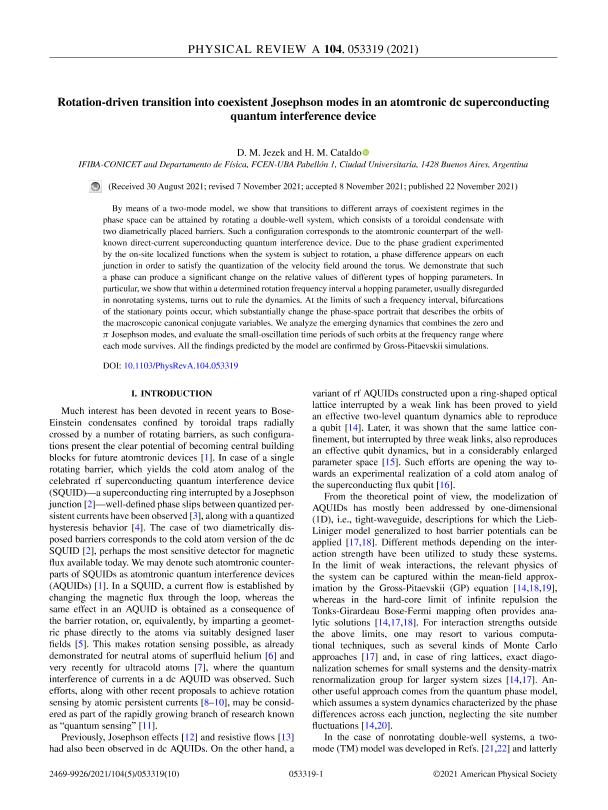Mostrar el registro sencillo del ítem
dc.contributor.author
Jezek, Dora Marta

dc.contributor.author
Cataldo, Horacio Maximo

dc.date.available
2022-12-22T11:07:39Z
dc.date.issued
2021-11
dc.identifier.citation
Jezek, Dora Marta; Cataldo, Horacio Maximo; Rotation-driven transition into coexistent Josephson modes in an atomtronic dc superconducting quantum interference device; American Physical Society; Physical Review A; 104; 5; 11-2021; 1-10
dc.identifier.issn
2469-9926
dc.identifier.uri
http://hdl.handle.net/11336/182117
dc.description.abstract
By means of a two-mode model, we show that transitions to different arrays of coexistent regimes in the phase space can be attained by rotating a double-well system, which consists of a toroidal condensate with two diametrically placed barriers. Such a configuration corresponds to the atomtronic counterpart of the well-known direct-current superconducting quantum interference device. Due to the phase gradient experimented by the on-site localized functions when the system is subject to rotation, a phase difference appears on each junction in order to satisfy the quantization of the velocity field around the torus. We demonstrate that such a phase can produce a significant change on the relative values of different types of hopping parameters. In particular, we show that within a determined rotation frequency interval a hopping parameter, usually disregarded in nonrotating systems, turns out to rule the dynamics. At the limits of such a frequency interval, bifurcations of the stationary points occur, which substantially change the phase-space portrait that describes the orbits of the macroscopic canonical conjugate variables. We analyze the emerging dynamics that combines the zero and π Josephson modes, and evaluate the small-oscillation time periods of such orbits at the frequency range where each mode survives. All the findings predicted by the model are confirmed by Gross-Pitaevskii simulations.
dc.format
application/pdf
dc.language.iso
eng
dc.publisher
American Physical Society

dc.rights
info:eu-repo/semantics/openAccess
dc.rights.uri
https://creativecommons.org/licenses/by-nc-sa/2.5/ar/
dc.subject
BOSE-EINSTEIN
dc.subject.classification
Física Atómica, Molecular y Química

dc.subject.classification
Ciencias Físicas

dc.subject.classification
CIENCIAS NATURALES Y EXACTAS

dc.title
Rotation-driven transition into coexistent Josephson modes in an atomtronic dc superconducting quantum interference device
dc.type
info:eu-repo/semantics/article
dc.type
info:ar-repo/semantics/artículo
dc.type
info:eu-repo/semantics/publishedVersion
dc.date.updated
2022-09-06T20:38:11Z
dc.identifier.eissn
2469-9934
dc.journal.volume
104
dc.journal.number
5
dc.journal.pagination
1-10
dc.journal.pais
Estados Unidos

dc.description.fil
Fil: Jezek, Dora Marta. Consejo Nacional de Investigaciones Científicas y Técnicas. Oficina de Coordinación Administrativa Ciudad Universitaria. Instituto de Física de Buenos Aires. Universidad de Buenos Aires. Facultad de Ciencias Exactas y Naturales. Instituto de Física de Buenos Aires; Argentina
dc.description.fil
Fil: Cataldo, Horacio Maximo. Consejo Nacional de Investigaciones Científicas y Técnicas. Oficina de Coordinación Administrativa Ciudad Universitaria. Instituto de Física de Buenos Aires. Universidad de Buenos Aires. Facultad de Ciencias Exactas y Naturales. Instituto de Física de Buenos Aires; Argentina
dc.journal.title
Physical Review A
dc.relation.alternativeid
info:eu-repo/semantics/altIdentifier/doi/http://dx.doi.org/10.1103/PhysRevA.104.053319
Archivos asociados
